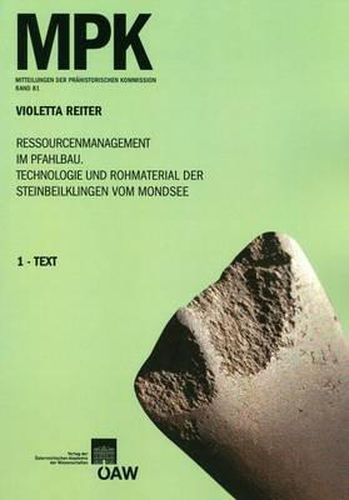Ressourcenmanagement Im Pfahlbau. Technologie Und Rohmaterial Der Steinbeilklingen Vom Mondsee
Violetta Reiter

Ressourcenmanagement Im Pfahlbau. Technologie Und Rohmaterial Der Steinbeilklingen Vom Mondsee
Violetta Reiter
English summary: In the 1870s, pile dwellings were discovered in Upper Austria’s Salzkammergut. Matthaus Much, a pioneer explorer of Austrian prehistory, recovered thousands of artefacts from the bottom of Lake Mondsee, where remnants of a Neolithic pile dwelling had survived 3-4 meters below the surface. Of these the organic relicts conserved under water for over 5000 years, such as food, pieces of twine and wooden artefacts, are especially noteworthy while the kind of decorated ceramics discovered there became the key feature defining the regional Mondsee-culture. Finds pertaining to the earliest procession of copper in the Eastern Alps are evidences of settlement activity in the Copper Age, as well. Apart from these artefacts, more than 400 stone axes were recovered. They provide an impressive insight into the technical skills of the Salzkammergut’s settlers of the Iceman’s time. Fitted into wooden shafts, they were universal tools as well as effective weapons. These stone axes are the subject of this thesis. They were analysed in form and size. The acquired data in this process was then evaluated and is presented in the form of diagrams and statistics. Based on the traces of manufacture and use, it can be reconstructed as well: process of production, repairing after damage and the utilisation of material depending on the type of raw material. To describe the living area it is important to have the knowledge of the location of raw material deposits. Accordingly, the petrological methods especially useful in archaeology for finding the location of rock deposits are introduced in conclusion. The richly illustrated text component is completed by an extensive catalogue. German description: In den 1870er Jahren wurden in den oberosterreichischen Salzkammergutseen Pfahlbausiedlungen entdeckt. Matthaus Much, Pionier der osterreichischen Urgeschichtsforschung, barg tausende Artefakte aus der in 3-4 Meter Tiefe am Seeboden erhaltenen Pfahlbausiedlung See am Mondsee. Besonders sind die 5000 Jahre alten Uberreste von Organischem - wie Lebensmittel, Schnure, Holzartefakte - hervorzuheben. Die verzierte Keramik wurde als Mondsee-Typus bekannt. Die fruhesten Spuren von Kupferverarbeitung im Ostalpenraum belegen die Siedlungstatigkeit in der Kupferzeit. Daneben bieten uber 400 Steinbeilklingen Einblick in das handwerkliche Geschick der Bewohner des Salzkammergutes zu Otzis Zeit. Die Steinbeilklingen, die in Holzholme geschaftet Universalwerkzeuge und wirkungsvolle Waffen darstellen, sind Gegenstand dieser Arbeit. Sie werden dem Leser metrisch und formanalytisch in Form von Diagrammen und Statistiken nahegebracht. Aufgrund von Produktions- und Gebrauchsspuren konnen die Herstellung einer Beilklinge, Reparatur nach Beschadigung und Materialausnutzung abhangig von der Gesteinsart rekonstruiert werden. Um den Lebensraum zu beschreiben, ist es von besonderem Interesse, uber die Lagerstatten der Gesteine der Beilklingen Kenntnis zu haben. Abschliessend werden petrologische Untersuchungsmethoden aus archaologischer Sicht vorgestellt, die der Erforschung der potentiellen Lagerstatten dienlich sind. Der reich bebilderte Textband wird von einem ausfuhrlichen Katalog erganzt.
This item is not currently in-stock. It can be ordered online and is expected to ship in approx 4 weeks
Our stock data is updated periodically, and availability may change throughout the day for in-demand items. Please call the relevant shop for the most current stock information. Prices are subject to change without notice.
Sign in or become a Readings Member to add this title to a wishlist.


